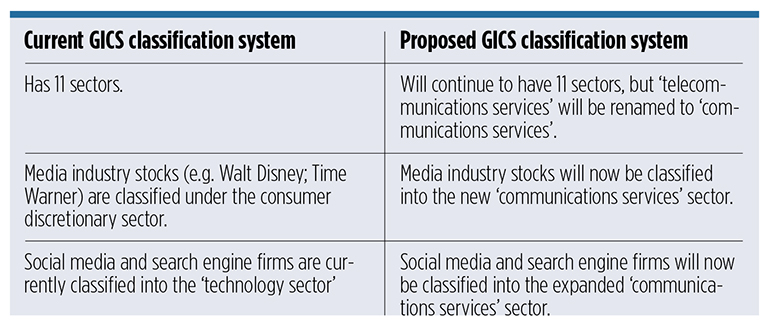Exchange traded funds that provide equity exposure to specific sectors have almost $330 billion in assets, and sector strategies are an important way many advisors construct their client portfolios.
But last month, the managers of the Global Industry Classification System announced a change to their methodology which will impact the holdings of some of the largest sector-based ETFs.
Every index-linked sector ETF is based on some underlying industry classification system that groups companies into different sectors or industries. That determines the composition of the index and by extension, the ETF linked to the index.
For example, a technology sector index needs to determine which stocks to classify as “technology” and which belong to another group. Is Amazon a technology stock or a consumer discretionary stock? Is Apple a technology company or a retail company? Does Facebook, innovative as it is, still belong in the technology group?
The most widely used industry classification system is GICS, which is jointly managed by the two of the largest index providers, S&P Dow Jones and MSCI. They consider Amazon a consumer discretionary stock. So an asset manager tracking an index based on the GICS will hold Amazon in its consumer discretionary ETF, but it won’t be found in its technology ETF. It’s clear the classification system is critical in determining ETF’s holdings and by extension, the portfolio composition of ETF investors.
Broadening of “telecommunications services” to “communications services”
In the GICS, there are 11 sectors, which in turn contain industries and sub-industries. One of the 11 sectors in the GICS is “telecommunications services.” Examples of ETFs that track this sector are the SPDR S&P Telecom ETF (XTL) and the Vanguard Telecommunications Services ETF (VOX).
This sector has shrunk over time due to mergers and acquisitions. Also, the differences between firms that create content and those that distribute it, have blurred. So the managers are broadening this GICS sector to include all types of media firms. Companies like Walt Disney and Time Warner that currently fall into the media industry within the “consumer discretionary” sector will now be moved into the renamed “communications services” sector.
Shifting of social media and search stocks
In addition, certain internet stocks that are currently classified into the technology GICS sector may also be moved into this expanded communication sector. As a result, the new communication services sector will combine telecom and media firms along with a few select internet stocks.

While the specific stocks impacted by the changes won’t be announced until January, it is likely some of the largest technology sector ETFs may no longer hold stocks like Facebook or Google. Those may go in the new communications sector ETFs.
Investors in communication services ETFs will now be getting combined exposure to broadcast media, social media, search engine and telecom stocks, rather than just pure-play telecom services. It will likely also hold stocks like Walt Disney, Time Warner, Netflix, Google and Facebook.
The GICS sector classification of stocks like Apple (currently in technology) and Amazon (consumer discretionary) will not likely change.
While S&P Dow Jones and MSCI will release the list of changes for large-cap firms in January, they won’t be effective until September 2018. Still, it will be important for advisors to monitor the announcements to understand how their clients’ ETF holdings and equity exposures will change.
Aniket Ullal is the founder and CEO of First Bridge Data, a provider of independent ETF data and analytics to institutional clients. Previously he had product management responsibility for S&P’s U.S. indices, including the widely followed S&P 500 and S&P/Case-Shiller indices. He is the author of ETF Investment Strategies (McGraw-Hill; 2013).





